Porcelain Insulator News
by Jack H. Tod, NIA #13
Reprinted from "INSULATORS - Crown Jewels of the Wire", January 1983, page 26
Dear Jack:
After months of quiet,
here's a new goodie, per the enclosed shadow profile and dimensional data (see
drawing at right). I've had many of the Fred Locke U-38's & U-39's over the
last 12 years but never one like this. This is the same crude mold and trimming
and the pretty Locke tan color. The Fred Locke incuse marking is only partially
legible, but is there.

I also came up with a light blue porcelain on a
porcelain-base pin assembly. It looks like Fred Locke manufacture, but it's
unmarked.
We're really excited about the 1983 NIA National being in Rochester,
and we're planning a truly great one.
Lew Hohn, NIA #1135,
Rochester, NY
- - - - - - - - - -
Dear
Lew:
This new find should really excite all the Fred Locke specialists, and it
will be U-40 in the Universal Style Chart.
Until your report, I've never heard
of anyone finding a porcelain base pin assembly with blue glazed porcelain. Too
bad it's unmarked, but from this distance it does "sound" like a Locke
item.
Jack
Dear Jack:
I happened to be in Bennington, Vermont recently attending
their annual antique car show. Having remembered your request last year in CJ
for someone to check out the insulators at the Bennington Pottery museum, I
decided to stop by there to check on them.
Unless I overlooked something, I
found only two insulators on display, and these were in a locked case
unavailable for close inspection. No one there had any information at all
concerning the insulators. I checked through a few of their publications
pertaining to Bennington pottery and still could not find a thing. I must admit
though that my time spent at the museum was brief and hasty, since we had to get
back to the car show. I hope the enclosed photos (one shown below) are of some
help to you.
Dave Zsido, NIA #2842
Rutland, Vermont

- - - - - - - - - - -
Dear Dave:
Yep, this really
answered my curiosity. Here we have this case of ancient 1850-ish jugs and
items, all moved back and crowded together to make a gaping space for inclusion
of these common 1920-ish pin types (style U-272) most probably made by Thomas
(Ohio) or Pittsburg High Voltage (Penna.). I just can't imagine what the donor
of these relatively modern insulators could have told the museum curators to
convince them that they were of Bennington Pottery origin.
In fact, the ruse of
these insulators being attributed by the museum to the Bennington Pottery now
leads me to believe that we have no basis at all for attributing the infamous
U-982 threadless to Bennington, regardless of the alleged museum connected
documentation to that effect. Deep down, I have always felt guilty about
connecting the U-982 with Bennington when it really didn't seem logical. The
original basis for the connection was probably nothing more than the insulator
having a pretty mottled glaze, but then here we have every antique store in the
country labeling all the millions of pretty old Locke, Ohio Brass and Pittsburg
insulators as "Bennington" just because of the mottled mahogany glaze
so common on many insulators of that period. I'm no longer a sheep following
that flock. Hereafter, I'll record the U-982 as "unattributed".
Thanks
very much for your help, Dave. Maybe it doesn't settle any questions for others,
but it sure does for me!
Jack
Dear Jack:
Enclosed is a photo of an odd insulator
that a friend of mine picked up in Alaska on or near Kodiak Island. The two legs
are 1"-thick porcelain, a very attractive cream or ivory color, and the
slot spacing for the conductors is 12". The porcelain legs are leaded into
a galvanized, cast iron base which attaches to the crossarm. If you have any
information an this insulator, we would like to know something about it.
George
T. Hanson, NIA #1844
Columbia Falls, Montana
- - - - - - - - - - -
(Note: The excellent photo of this
item was part of the loss in the mailed copy last year, but the very rough
sketch from memory here should suffice to show the nature of the item.)
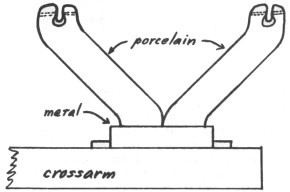
Dear
George:
Very interesting item. I have some info, but not much. Eleven years ago
I traded an Ohio collector for two insulators obviously identical in concept and
manufacture (see sketch below). Mine are also ivory-white glaze, are 1"
thick porcelain and have 7/16" and 9/16" mounting holes, each having a
flanged lead bushing. Chester and Betty Morris of El Paso got another one
identical to mine at a 1975 insulator show.
The Ohio collector from whom I got
mine either had a bunch of these or got these he had from a large bunch found
crated in a warehouse, and he had a specification sheet that came in the crate.
He wouldn't part with the sheet, but I copied down the source name and a couple
of installation notes. They indicated a tie-wire method as I sketched below. The
mounting is by bolts through the porcelain holes to two sturdy "U"
brackets bolted to the crossarm. The source name just as I copied it down was:
"Transmission Line Insulator (Ceramic)"
Wind Turbine Co.
West Chester,
Penna.
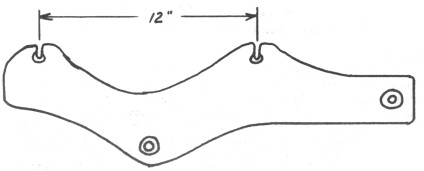
The spec sheet showed a drawing of the tie-wire method (sketch at right).
I have a hunch that this whole thing is of 1940's origin, so it was no surprise
to learn that there is no telephone listing for the Wind Turbine Co. in West
Chester. Possibly we could learn about this company if some collector living in
that area could dig out the information directly from sources in West Chester.
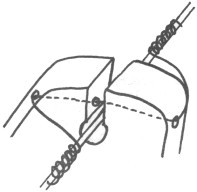
We're naturally very interested in the specialized usage, user agency, vintage,
porcelain manufacturer, etc.
Jack
Dear Jack:
Last month at a flea market I saw
this odd thing lying among some insulators on a table (see rough sketch below).
It has the Ohio Brass Co. monogram-OB marking embossed on the brass hook. The
person with the table said the item was a mine insulator out of a mine in
northern N.Y. state, but I bought it and would like your opinion on that.
Bill Mueller, NIA #834
Buffalo, N.Y.
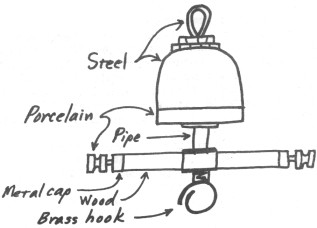
- - - - - - - - - -
Dear
Bill:
As manufactured and sold for many years by a number of companies, your
item was called a "lamp hanger insulator" or a "triple insulator
arm" and was used for suspending series street lights as I've sketched
below. Although the voltage across each lamp in the series string is relatively
low, the overall loop voltage potential to ground is several thousand volts.
Thus the need for the insulation from the mast-arm from which the lamp is hung.
The spool insulators on the horizontal arm provide an anchor point for the wires
leading from the through line to the terminal bushings of the luminary housing.
The lamps are entered into the series string by several methods. I've sketched
below the use of a two-groove pin type to break the wire. Alternatively the
through wire can be broken with a break insulator (sometimes an ordinary guy
strain) at one side of a regular pin type. Instead of the guy strain to deadend
the two ends of the through wire, a porcelain rod with FARGO clamps in each end
can be used, and this is the easiest way to break already existing lines; you
merely cut the through wire and insert the FARGO break insulator. All three of
these breaking methods can be seen this day on the Phoenix street lighting
circuits.
This insulator might have been used at a mine, but if it was used in a
mine as a "mine insulator" for any ordinary wiring there, it would be
something like using a chain saw to cut your birthday cake. These old arc lamp
hangers are real antiques and deserve top spot on collectors' shelves. If you
can come up with one of the ancient arc lamps to hang on it, so much the better!
Interestingly too, some of the very old arrangements had a rope and pulley
arrangement between the mast-arm and lamp hanger so it could be lowered to the
ground to adjust the carbon arc rods in the luminary.
Jack
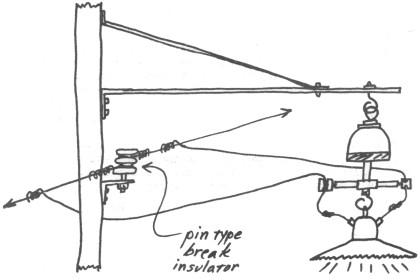
SHORT CIRCUITS: The
1982 directory of the American Ceramic Society lists "Brown Boveri
Electric, Inc., Insulator Division" for the insulator plant at Victor, N.Y.
-- most recently owned by Gould, Inc, and previously ex-I.T.E. etc. We've made
written inquiry to the company for information on the corporate changes and any
changes in the marking used on their insulators -- as would be expected.
The
1982 A.C.S. directory also lists Canadian Porcelain Co. (Hamilton, Ont., Canada)
as a subsidiary of Gould Inc., and that might cause a new marking on their
insulators. We will also make inquiry to that plant for information on the
corporate change and insulator markings now in use there.
Jack

Dear Jack:
This
insulator was given to me by a man who lives in Mt. Vernon, Washington. It is a
green glaze with light banding about the edges of the wire groove and on the
mold lines. I have never seen one like it and would like to know its value.
Donald T. Bowers
Grand Rapids, Mich.
- - - - - - - - - - -
Dear Donald:
The shadow profile of your
insulator, plus the mold line detail on it, agree exactly with the U-11A
specimens with the "G" embossed on the crown. We've never been able to
ascertain with certainty what company used this "G" marking.
Although
possibly obscured by the glaze, you can check the top of the crown to see if you
can detect any trace of the "G" or four raised (venting) dots there.
My guess on value of this item would be a $3 sticker price at an insulator show.
Even with an unusual green glaze, collectors aren't overly excited about common
styles which can't be attributed to manufacturer.
Jack

Dear Jack:
The other day
I came across some Illinois U-467's in white. They have the incuse map marking
with 247 inside the map and the number 26 above the map. I have never seen a
white Illinois until now. Are they scarce?
There are many Illinois styles in use
around here, and I have found U-244 and U-244A's with the "MACOMB"
embossing. In the old San Jauquin Light & Power Company there were quite a
few of these U-244A's. One time I threw away about 12 of the U-244A. At the
present time I have no more of them, as I gave them all away.
Robert Chiantelli
Monterey, California
- - - - - - - - - - -
Dear Robert:
The 26 on top of the map marking on your
Illinois catalog #247 item indicates the year of manufacture, 1926. Although I
don't recall seeing too many Illinois cable insulators with white glaze in
collections or at insulator shows, I don't think one should term them other than
uncommon.
You're missing a bet if you don't try to get those U-244A MACOMB items
into collector circles. A number of collectors have tried to complete the set of
the Illinois dry press pin types with the MACOMB marking, but at least a few
years ago nearly everyone lacked this one style. Note in the Second Edition of
the Porcelain Insulators Guide Book where we indicated for it "Only one to
several specimens known; value not established." If the collectors still
needing it knew you'd pitched some into the dump, they'd skin you alive!
Jack

Dear Jack:
On a recent dig on the old New York - Boston A.T.& T. line, we
dug up two brown porcelain insulators like the sketch enclosed. I was talking to
a porcelain collector at a recent show, and he had also found a couple of these
same insulators on a line along the Connecticut shore, but he could give no
further information.
Since a bunch of glass CD-146's were found as replacements,
could they have been quick, cheap replacements? It's kind of a heavy insulator
for a telephone/telegraph circuit. The Naugatuck Lighting Co. was formed about
that time, but it's hardly possible they string wires in the middle of what was
then nowhere, and even less likely that they borrowed AT&T's poles.
Steven
Jones
Naugatuck, Conn.
- - - - - - - - - - -
Dear Steven:
The insulator you mention is a rather common
form of pin type made by a number of the larger insulator manufacturers in past
years. I'd date most of those being manufactured in the 1915-1940 period --
probably the majority in the 1920's.
Really, it's a hopeless task to try to
deduce why these were used as vs. any other suitable pin type, or why they would
show up in any given area as opposed to somewhere else. As with many other
styles of glass and porcelain pin types, this given one is just as useable for
communications or low-voltage power work as any of the other styles.
The
majority of the small, independent phone, power or railroad companies weren't
very fussy about what they used for insulators. They ordered whatever was cheap
or readily available, and they continually salvaged serviceable insulators from
any lines and used them randomly on any other lines. Because of this treatment
of "an insulator is an insulator is an...", many of the lines of the
small phone and electric companies out here had lines with a super "Duke's
mixture" on the crossarms. You'd think that back east in the older and more
populated areas it would be even more so a case of that.
Jack
| 